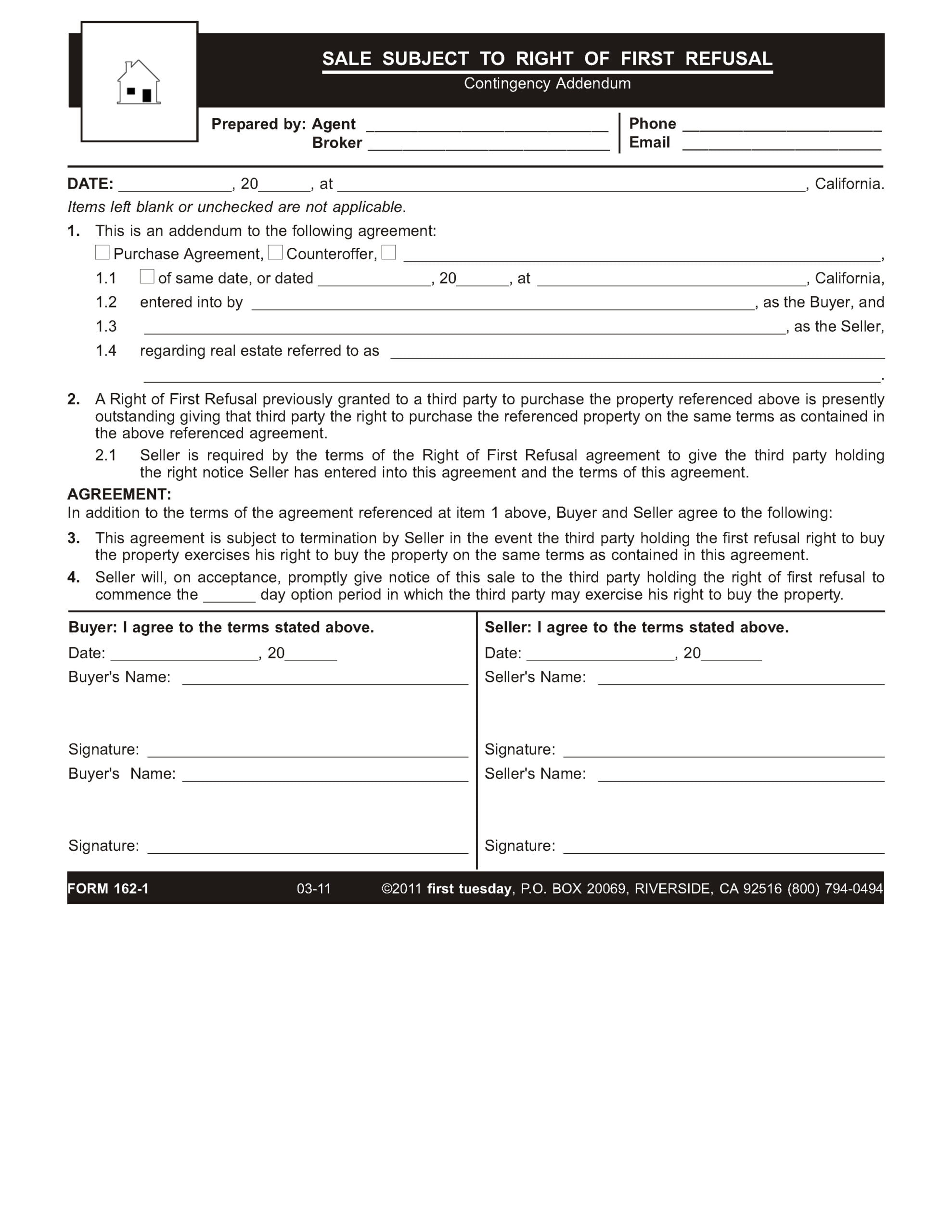This form is used by an agent when negotiating the sale of a property on which another person holds a right of first refusal to purchase the property, to prepare a contingency provision for waiver of the right of first refusal right as an addendum for an offer to buy or counteroffer.
The two types of right of first refusal
A right of first refusal is a pre-emptive right granted by the owner of a property and held by another to buy a property when the owner decides to sell.
A right of first refusal form is usually attached as an addendum to a:
- purchase agreement [See RPI Form 150]; or
- lease agreement. [See RPI Form 550]
When attached to a purchase agreement — or, alternatively, a counteroffer or escrow instructions — the right of first refusal references a property other than the property being sold under the purchase agreement. The seller grants a right of first refusal to buy another property they own in the event they decide to sell it by using a Right of First Refusal — To Acquire Additional Property form. [See RPI Form 162]
On the other hand, when attached to a lease agreement, the right of first refusal is between the landlord and tenant. Here, the tenant is granted the pre-emptive right to buy the leased premises in the event the landlord decides to sell it. The landlord grants the tenant the right of “first dibs” to acquire the property by using the Right of First Refusal to Buy — Addendum form. [See RPI Form 579]
Pros and cons of a right of first refusal
Before walking a client through a first refusal agreement, ask them to consider the pros and cons.
Advantages for buyers:
- priority: the buyer holds the right to the first opportunity to purchase the property when the owner decides to sell;
- obligations: the buyer does not agree to buy or otherwise acquire the property when the owner decides to sell; and
- security: the buyer has the assurance they can opt to acquire the described property when the owner decides to sell it.
Disadvantages for buyers:
- uncertainty: the buyer does not know when the owner might decide to sell, or whether the owner will ever sell the property.
Advantages for owners:
- transaction efficiency: when the buyer exercises their right of first refusal on the owner’s notice of their decision to sell, the transaction is more likely to close smoothly as the buyer has already been located and is known to the owner; and
- a safety net: the owner has greater certainty they likely have a buyer when they decide to sell.
Disadvantages for owners:
- sales options limited: the owner on deciding to sell has agreed to offer the property to the holder of the right of first refusal before unconditionally agreeing to sell it to another person; and
- delays: the owner on notifying the holder of the first refusal right of the owner’s intent to sell needs to wait for the holder to decide whether to exercise their right to purchase the property.
Analyzing a sale subject to a right of first refusal
An agent uses the Sale Subject to Right of First Refusal — Contingency Addendum form published by RPI when negotiating with a buyer of a property on which another person holds a right of first refusal to purchase the property. [See RPI Form 162-1]
The sections of the Sale Subject to Right of First Refusal — Contingency Addendum include:
- Facts, which identify the purchase agreement the notice is attached to as an addendum, the date of the agreement, the buyer and seller’s identities and a description of the real estate [See RPI Form 162-1 §1];
- Notice of existing right of first refusal, which discloses the property is subject to a right of first refusal held by another person who may purchase the property by exercising their right to buy the property [See RPI Form 162-1 §2];
- Provisions, including:
- the purchase agreement is subject to cancellation by the seller in the event the first refusal right to buy the property is exercised [See RPI Form 162-1 §3]; and
- the seller will, on acceptance, promptly notify the holder of the first refusal that they may exercise their right to buy the property and the time period for exercise [See RPI Form 162-1 §4]; and
- Signatures of the buyer and seller.
Form navigation page published 03-2023.
Form last revised 2011.
Form-of-the-Week: Right of First Refusal Addenda — Forms 162, 162-1 and 162-2
Form-of-the-Week: Right of First Refusal to Buy and Right of First Refusal to Lease – Forms 579 and 579-1
Word-of-the-Week: Right of First Refusal
Article: The right of first refusal
Book: Real Estate Property Management, Chapter 6: Options and the right of first refusal to buy
Recent Case Decision: Does an owner hold a right of first refusal to recover property an agency takes by condemnation when the property is not used for its intended purpose within 10 years?
Recent Case Decision: Does a right-of-first refusal granted in a lease agreement survive when the lease ends and the tenant continues possession on a month-to-month basis?
Recent Case Decision: Is a property owner who leases a property to a tenant who holds a right of first refusal required to notify the tenant and allow them to purchase the property on terms agreed to with a buyer?











